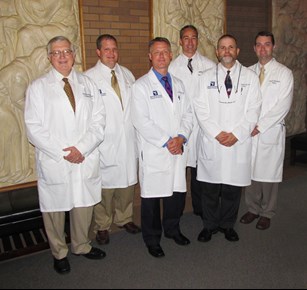General Surgery

Professor of Surgery, Chief Section of General Surgery
The General Surgery Services are provided by all members of the department, with experts recognized for their ability to solve problems associated with complex surgical presentations. They provide state-of-the-art treatment for a multitude of conditions, and take care of patients referred from all corners of the state and beyond. Frequently, they work in teams to approach oncologic, endocrine and uncommon surgical problems requiring cutting edge know-how, with results that validate their technical skill and dedication to patient safety and satisfaction. The most current scientific knowledge is a staple of the faculty’s daily discussions regarding patient management, and the expertise of the surgeons in the department provides patients with diagnostic and treatment opportunities otherwise less commonly available in different settings. Such is the case, for instance, with complex reconstruction of abdominal wall defects, often performed nowadays by a technique known as “component separation,” that leads to an improvement of post-surgical function not consistently achieved with older methods. In any 12 month period, the department’s surgeons perform approximately 6,000 diagnostic and
The General Surgery Services are provided by all members of the department, with experts recognized for their ability to solve problems associated with complex surgical presentations.

Dr. Lohan, Dr. Witsberger, Dr. Elmore
They provide state-of-the-art treatment for a multitude of conditions, and take care of patients referred from all corners of the state and beyond. Frequently, they work in teams to approach oncologic, endocrine and uncommon surgical problems requiring cutting edge know-how, with results that validate their technical skill and dedication to patient safety and satisfaction. The most current scientific knowledge is a staple of the faculty’s daily discussions regarding patient management, and the expertise of the surgeons in the department provides patients with diagnostic and treatment opportunities otherwise less commonly available in different settings. Such is the case, for instance, with complex reconstruction of abdominal wall defects, often performed nowadays by a technique known as “component separation,” that leads to an improvement of post-surgical function not consistently achieved with older methods.
In any 12 month period, the department’s surgeons perform approximately 6,000 diagnostic and general operative procedures.
A selection includes:
- Laparoscopic cholecystectomy: 444
- Laparoscopic appendectomy: 221
- Hernias (all types, including laparoscopic): 157
- Incisional hernia(including component separation and laparoscopic): 151
- Small bowel procedures: 181
- Colon procedures: 229
- Fundoplasty (including laparoscopic hiatal hernia): 26
- Upper GI endoscopy: 103
- Gastric neurostimulator (mostly diabetic patients): 9